Dynamic Strategy and Disruptive Innovation Analysis for MHS Report
VerifiedAdded on 2023/01/20
|11
|2516
|35
Report
AI Summary
This report provides a comprehensive analysis of disruptive innovation, focusing on the case study of Millennium Health Sciences (MHS). The report examines the organization's capacity to innovate from various perspectives, including internal structures like human resources, organizational culture, resource allocation, and organizational structure. It also explores external factors such as commitments and relationships, as well as regulatory and economic conditions. Furthermore, the report delves into the marketing perspective, analyzing customer visit programs, empathic designs, and lead-user processes. The analysis includes recommendations for each area, aiming to enhance MHS's ability to manage innovation effectively. The report concludes by emphasizing the importance of factors like technology, knowledge management, and employee involvement in driving successful disruptive innovation within the organization. The report highlights the importance of adapting to technological changes and the significance of a dynamic strategy for sustained market leadership.
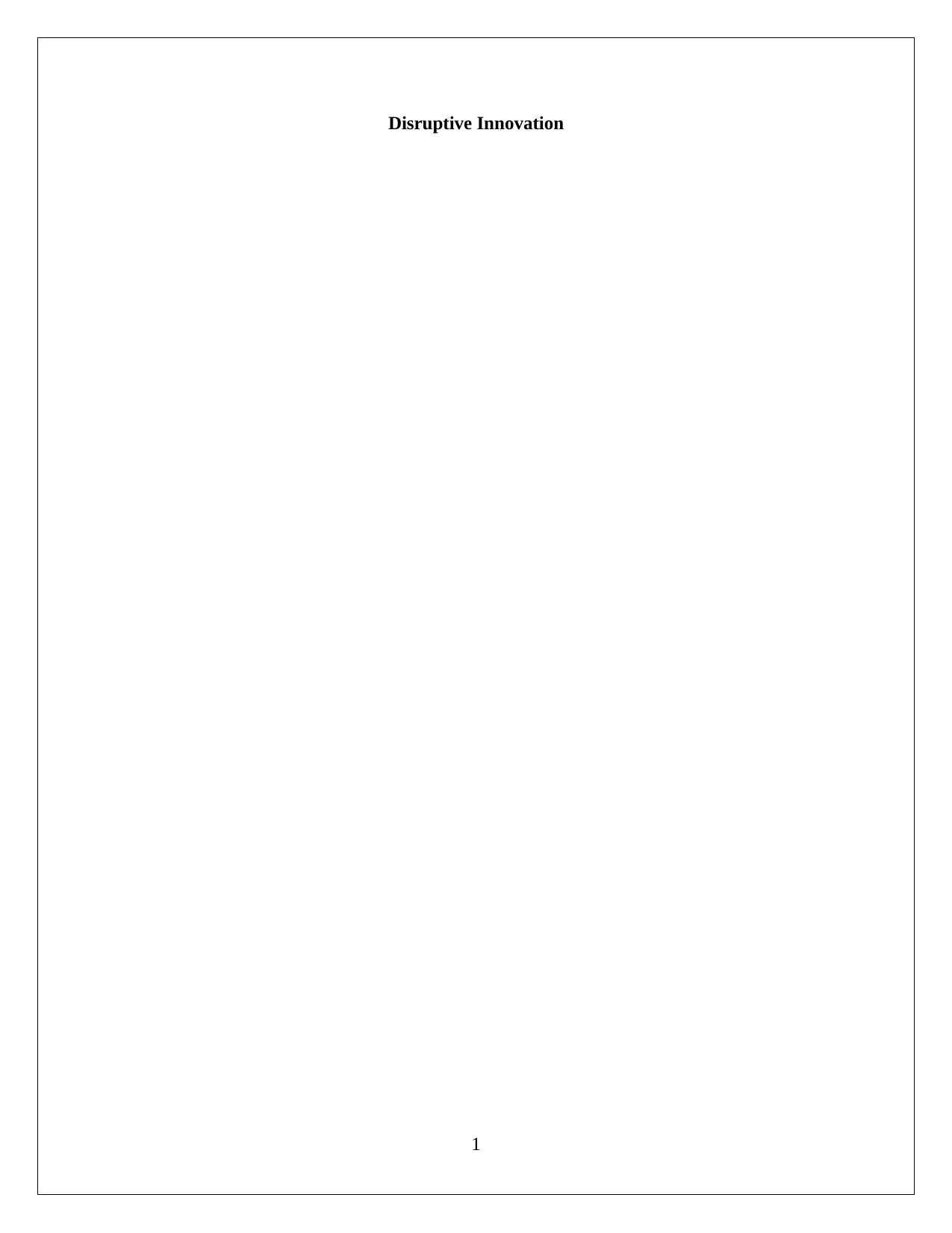
Disruptive Innovation
1
1
Paraphrase This Document
Need a fresh take? Get an instant paraphrase of this document with our AI Paraphraser
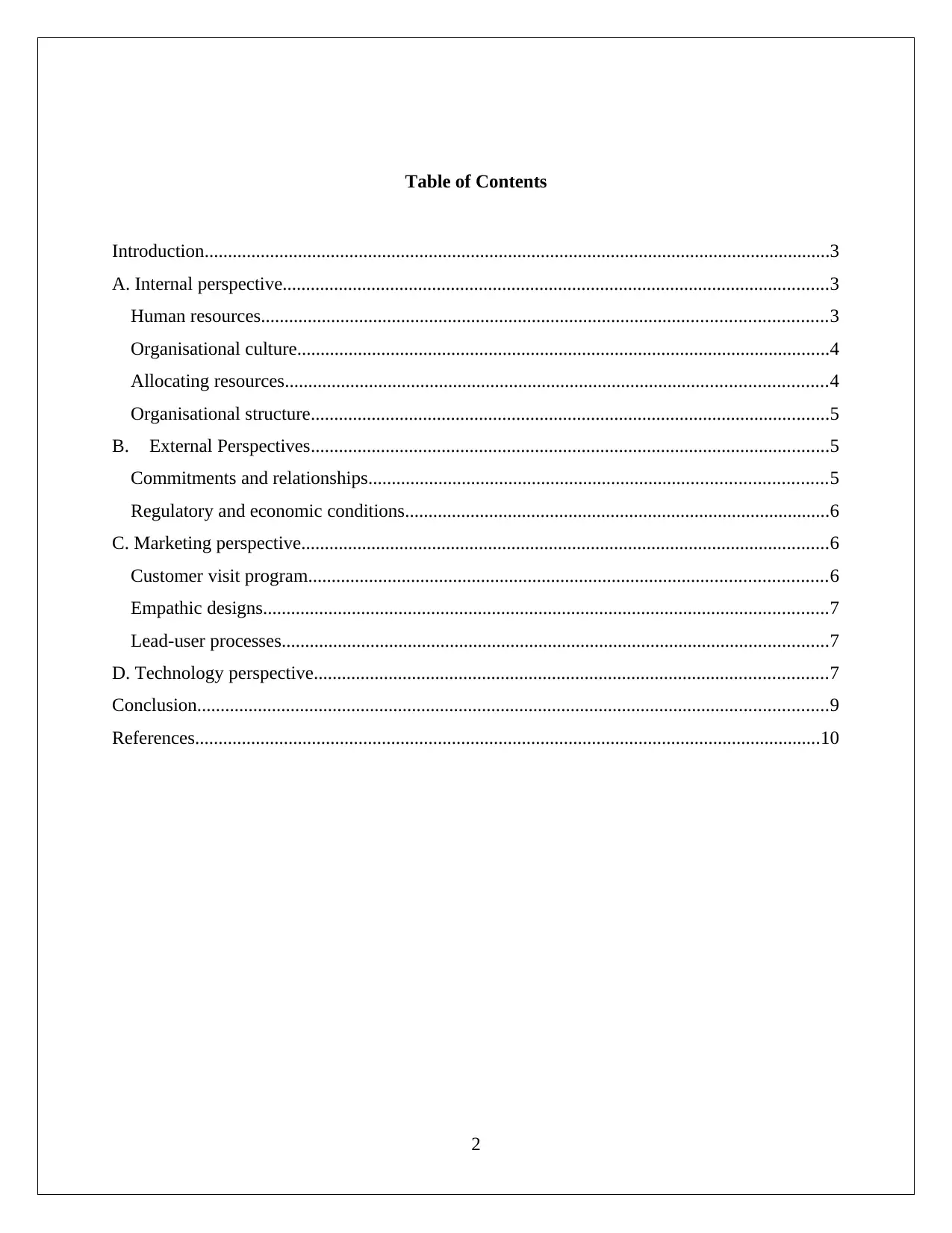
Table of Contents
Introduction......................................................................................................................................3
A. Internal perspective.....................................................................................................................3
Human resources.........................................................................................................................3
Organisational culture..................................................................................................................4
Allocating resources....................................................................................................................4
Organisational structure...............................................................................................................5
B. External Perspectives...............................................................................................................5
Commitments and relationships..................................................................................................5
Regulatory and economic conditions...........................................................................................6
C. Marketing perspective.................................................................................................................6
Customer visit program...............................................................................................................6
Empathic designs.........................................................................................................................7
Lead-user processes.....................................................................................................................7
D. Technology perspective..............................................................................................................7
Conclusion.......................................................................................................................................9
References......................................................................................................................................10
2
Introduction......................................................................................................................................3
A. Internal perspective.....................................................................................................................3
Human resources.........................................................................................................................3
Organisational culture..................................................................................................................4
Allocating resources....................................................................................................................4
Organisational structure...............................................................................................................5
B. External Perspectives...............................................................................................................5
Commitments and relationships..................................................................................................5
Regulatory and economic conditions...........................................................................................6
C. Marketing perspective.................................................................................................................6
Customer visit program...............................................................................................................6
Empathic designs.........................................................................................................................7
Lead-user processes.....................................................................................................................7
D. Technology perspective..............................................................................................................7
Conclusion.......................................................................................................................................9
References......................................................................................................................................10
2
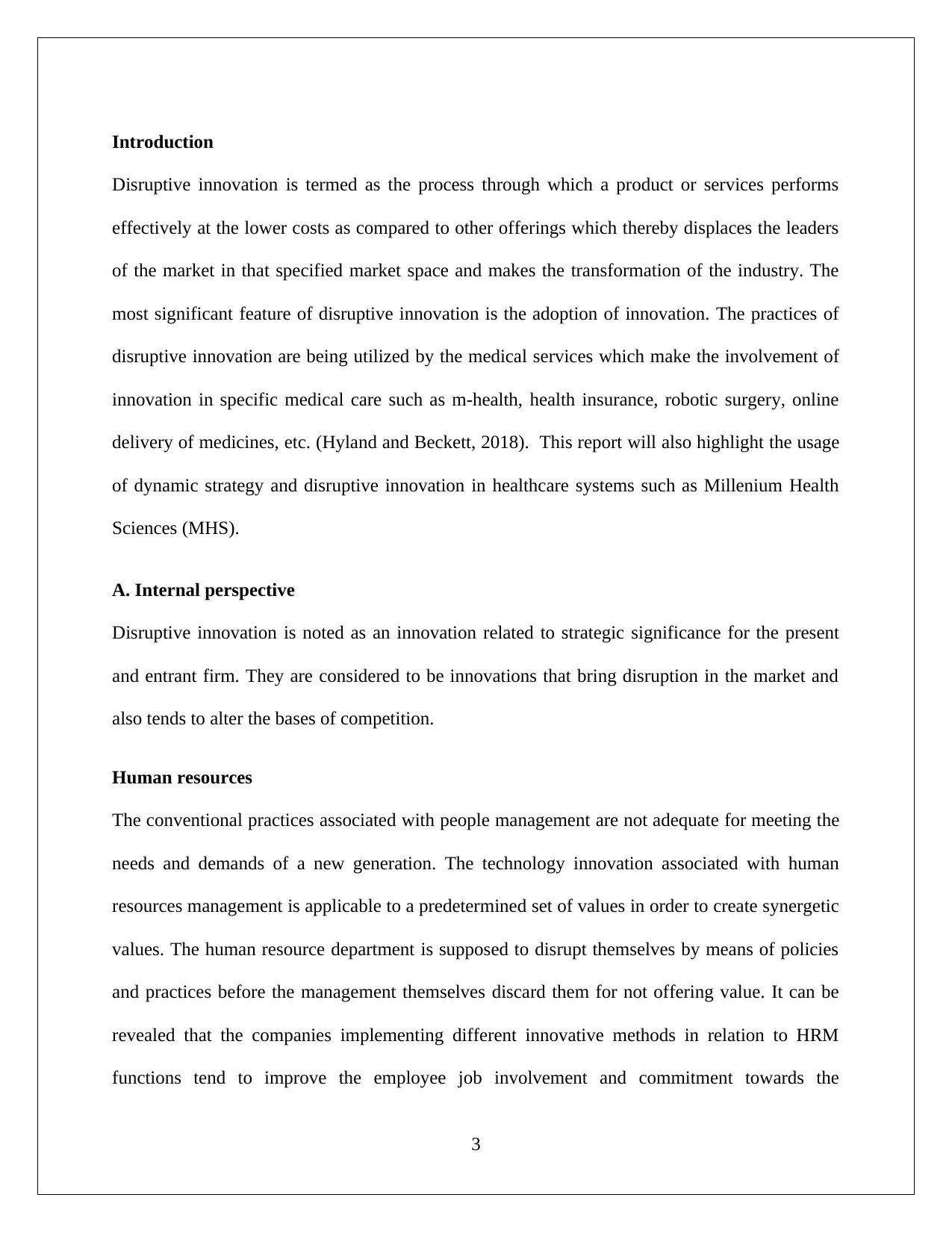
Introduction
Disruptive innovation is termed as the process through which a product or services performs
effectively at the lower costs as compared to other offerings which thereby displaces the leaders
of the market in that specified market space and makes the transformation of the industry. The
most significant feature of disruptive innovation is the adoption of innovation. The practices of
disruptive innovation are being utilized by the medical services which make the involvement of
innovation in specific medical care such as m-health, health insurance, robotic surgery, online
delivery of medicines, etc. (Hyland and Beckett, 2018). This report will also highlight the usage
of dynamic strategy and disruptive innovation in healthcare systems such as Millenium Health
Sciences (MHS).
A. Internal perspective
Disruptive innovation is noted as an innovation related to strategic significance for the present
and entrant firm. They are considered to be innovations that bring disruption in the market and
also tends to alter the bases of competition.
Human resources
The conventional practices associated with people management are not adequate for meeting the
needs and demands of a new generation. The technology innovation associated with human
resources management is applicable to a predetermined set of values in order to create synergetic
values. The human resource department is supposed to disrupt themselves by means of policies
and practices before the management themselves discard them for not offering value. It can be
revealed that the companies implementing different innovative methods in relation to HRM
functions tend to improve the employee job involvement and commitment towards the
3
Disruptive innovation is termed as the process through which a product or services performs
effectively at the lower costs as compared to other offerings which thereby displaces the leaders
of the market in that specified market space and makes the transformation of the industry. The
most significant feature of disruptive innovation is the adoption of innovation. The practices of
disruptive innovation are being utilized by the medical services which make the involvement of
innovation in specific medical care such as m-health, health insurance, robotic surgery, online
delivery of medicines, etc. (Hyland and Beckett, 2018). This report will also highlight the usage
of dynamic strategy and disruptive innovation in healthcare systems such as Millenium Health
Sciences (MHS).
A. Internal perspective
Disruptive innovation is noted as an innovation related to strategic significance for the present
and entrant firm. They are considered to be innovations that bring disruption in the market and
also tends to alter the bases of competition.
Human resources
The conventional practices associated with people management are not adequate for meeting the
needs and demands of a new generation. The technology innovation associated with human
resources management is applicable to a predetermined set of values in order to create synergetic
values. The human resource department is supposed to disrupt themselves by means of policies
and practices before the management themselves discard them for not offering value. It can be
revealed that the companies implementing different innovative methods in relation to HRM
functions tend to improve the employee job involvement and commitment towards the
3
⊘ This is a preview!⊘
Do you want full access?
Subscribe today to unlock all pages.

Trusted by 1+ million students worldwide
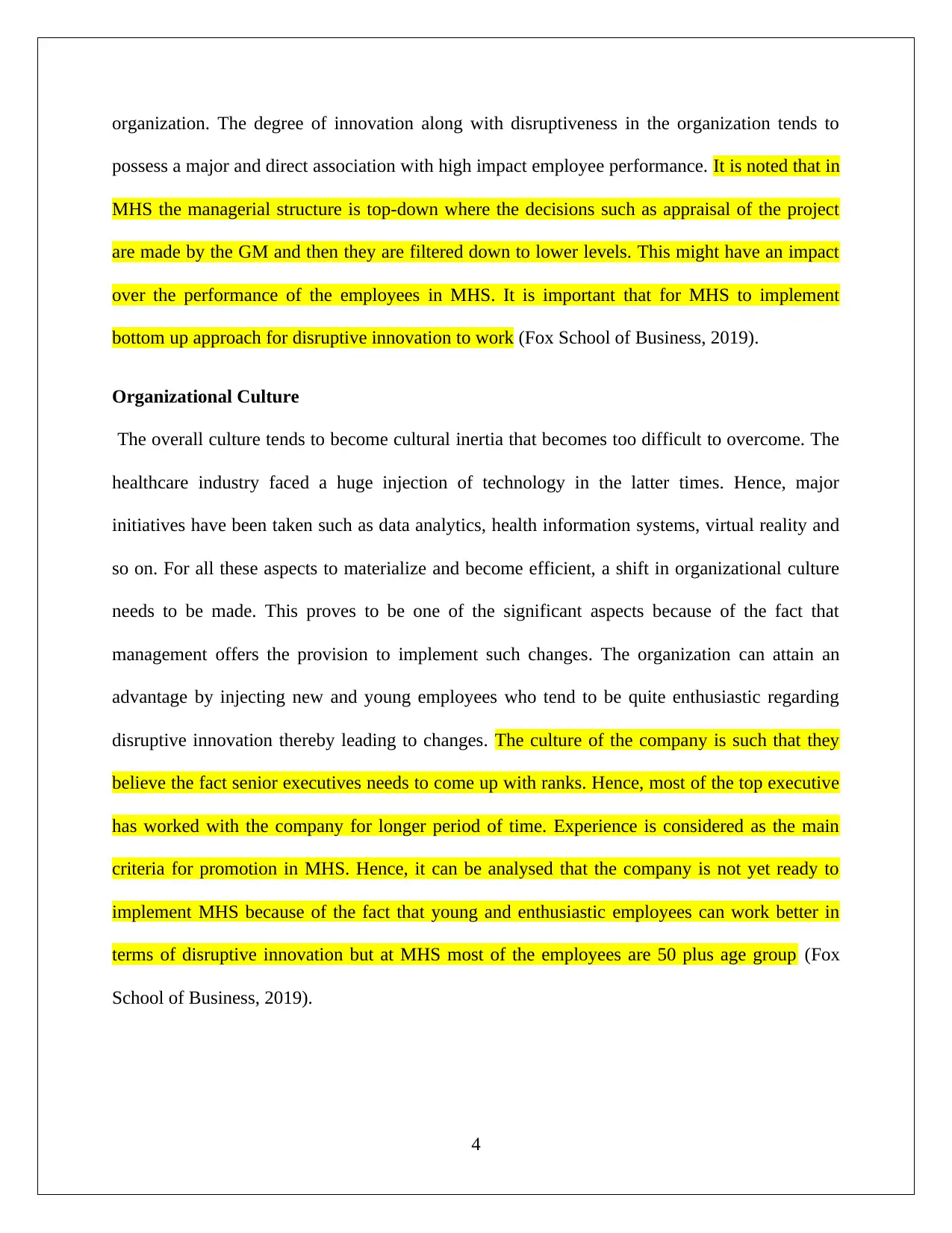
organization. The degree of innovation along with disruptiveness in the organization tends to
possess a major and direct association with high impact employee performance. It is noted that in
MHS the managerial structure is top-down where the decisions such as appraisal of the project
are made by the GM and then they are filtered down to lower levels. This might have an impact
over the performance of the employees in MHS. It is important that for MHS to implement
bottom up approach for disruptive innovation to work (Fox School of Business, 2019).
Organizational Culture
The overall culture tends to become cultural inertia that becomes too difficult to overcome. The
healthcare industry faced a huge injection of technology in the latter times. Hence, major
initiatives have been taken such as data analytics, health information systems, virtual reality and
so on. For all these aspects to materialize and become efficient, a shift in organizational culture
needs to be made. This proves to be one of the significant aspects because of the fact that
management offers the provision to implement such changes. The organization can attain an
advantage by injecting new and young employees who tend to be quite enthusiastic regarding
disruptive innovation thereby leading to changes. The culture of the company is such that they
believe the fact senior executives needs to come up with ranks. Hence, most of the top executive
has worked with the company for longer period of time. Experience is considered as the main
criteria for promotion in MHS. Hence, it can be analysed that the company is not yet ready to
implement MHS because of the fact that young and enthusiastic employees can work better in
terms of disruptive innovation but at MHS most of the employees are 50 plus age group (Fox
School of Business, 2019).
4
possess a major and direct association with high impact employee performance. It is noted that in
MHS the managerial structure is top-down where the decisions such as appraisal of the project
are made by the GM and then they are filtered down to lower levels. This might have an impact
over the performance of the employees in MHS. It is important that for MHS to implement
bottom up approach for disruptive innovation to work (Fox School of Business, 2019).
Organizational Culture
The overall culture tends to become cultural inertia that becomes too difficult to overcome. The
healthcare industry faced a huge injection of technology in the latter times. Hence, major
initiatives have been taken such as data analytics, health information systems, virtual reality and
so on. For all these aspects to materialize and become efficient, a shift in organizational culture
needs to be made. This proves to be one of the significant aspects because of the fact that
management offers the provision to implement such changes. The organization can attain an
advantage by injecting new and young employees who tend to be quite enthusiastic regarding
disruptive innovation thereby leading to changes. The culture of the company is such that they
believe the fact senior executives needs to come up with ranks. Hence, most of the top executive
has worked with the company for longer period of time. Experience is considered as the main
criteria for promotion in MHS. Hence, it can be analysed that the company is not yet ready to
implement MHS because of the fact that young and enthusiastic employees can work better in
terms of disruptive innovation but at MHS most of the employees are 50 plus age group (Fox
School of Business, 2019).
4
Paraphrase This Document
Need a fresh take? Get an instant paraphrase of this document with our AI Paraphraser
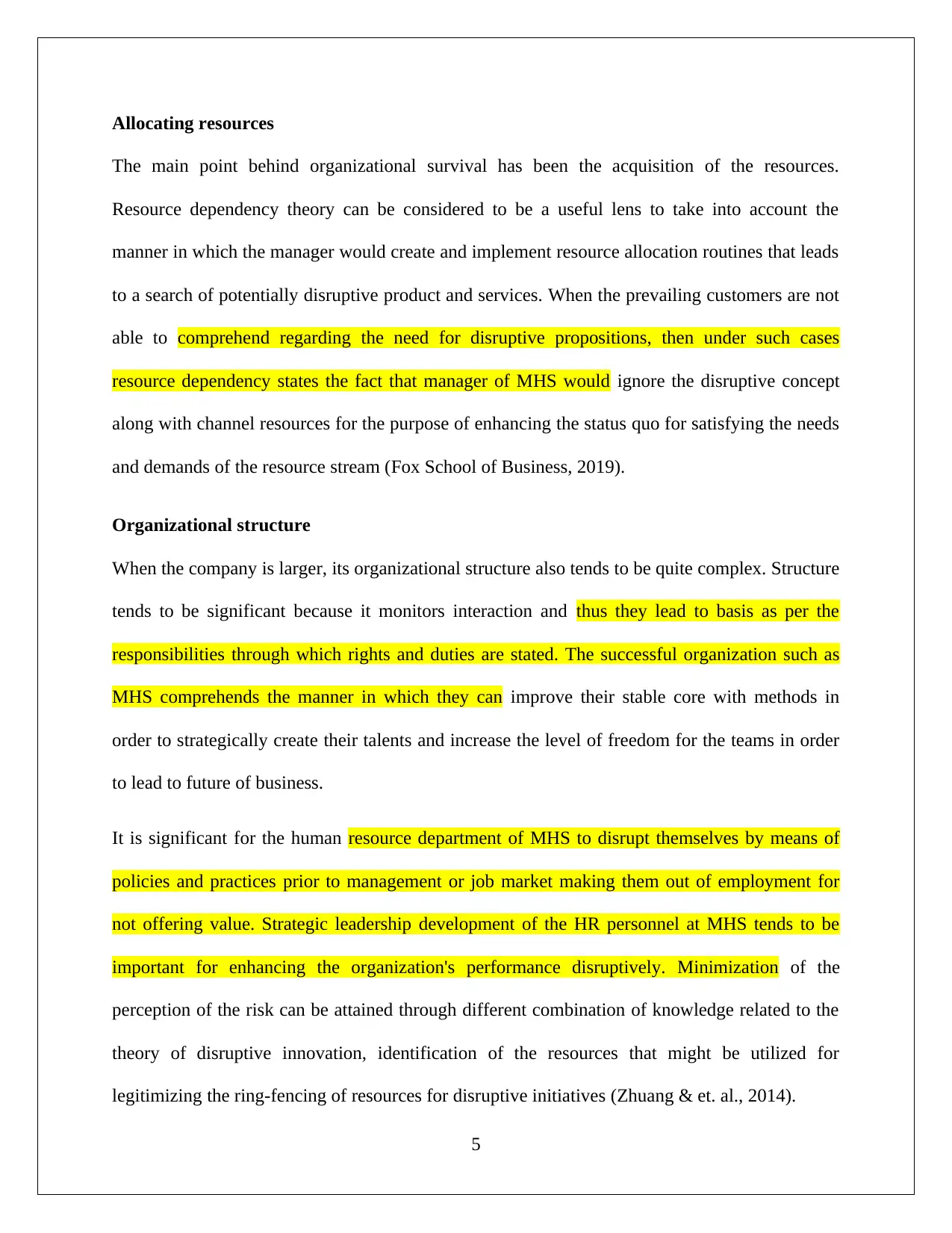
Allocating resources
The main point behind organizational survival has been the acquisition of the resources.
Resource dependency theory can be considered to be a useful lens to take into account the
manner in which the manager would create and implement resource allocation routines that leads
to a search of potentially disruptive product and services. When the prevailing customers are not
able to comprehend regarding the need for disruptive propositions, then under such cases
resource dependency states the fact that manager of MHS would ignore the disruptive concept
along with channel resources for the purpose of enhancing the status quo for satisfying the needs
and demands of the resource stream (Fox School of Business, 2019).
Organizational structure
When the company is larger, its organizational structure also tends to be quite complex. Structure
tends to be significant because it monitors interaction and thus they lead to basis as per the
responsibilities through which rights and duties are stated. The successful organization such as
MHS comprehends the manner in which they can improve their stable core with methods in
order to strategically create their talents and increase the level of freedom for the teams in order
to lead to future of business.
It is significant for the human resource department of MHS to disrupt themselves by means of
policies and practices prior to management or job market making them out of employment for
not offering value. Strategic leadership development of the HR personnel at MHS tends to be
important for enhancing the organization's performance disruptively. Minimization of the
perception of the risk can be attained through different combination of knowledge related to the
theory of disruptive innovation, identification of the resources that might be utilized for
legitimizing the ring-fencing of resources for disruptive initiatives (Zhuang & et. al., 2014).
5
The main point behind organizational survival has been the acquisition of the resources.
Resource dependency theory can be considered to be a useful lens to take into account the
manner in which the manager would create and implement resource allocation routines that leads
to a search of potentially disruptive product and services. When the prevailing customers are not
able to comprehend regarding the need for disruptive propositions, then under such cases
resource dependency states the fact that manager of MHS would ignore the disruptive concept
along with channel resources for the purpose of enhancing the status quo for satisfying the needs
and demands of the resource stream (Fox School of Business, 2019).
Organizational structure
When the company is larger, its organizational structure also tends to be quite complex. Structure
tends to be significant because it monitors interaction and thus they lead to basis as per the
responsibilities through which rights and duties are stated. The successful organization such as
MHS comprehends the manner in which they can improve their stable core with methods in
order to strategically create their talents and increase the level of freedom for the teams in order
to lead to future of business.
It is significant for the human resource department of MHS to disrupt themselves by means of
policies and practices prior to management or job market making them out of employment for
not offering value. Strategic leadership development of the HR personnel at MHS tends to be
important for enhancing the organization's performance disruptively. Minimization of the
perception of the risk can be attained through different combination of knowledge related to the
theory of disruptive innovation, identification of the resources that might be utilized for
legitimizing the ring-fencing of resources for disruptive initiatives (Zhuang & et. al., 2014).
5
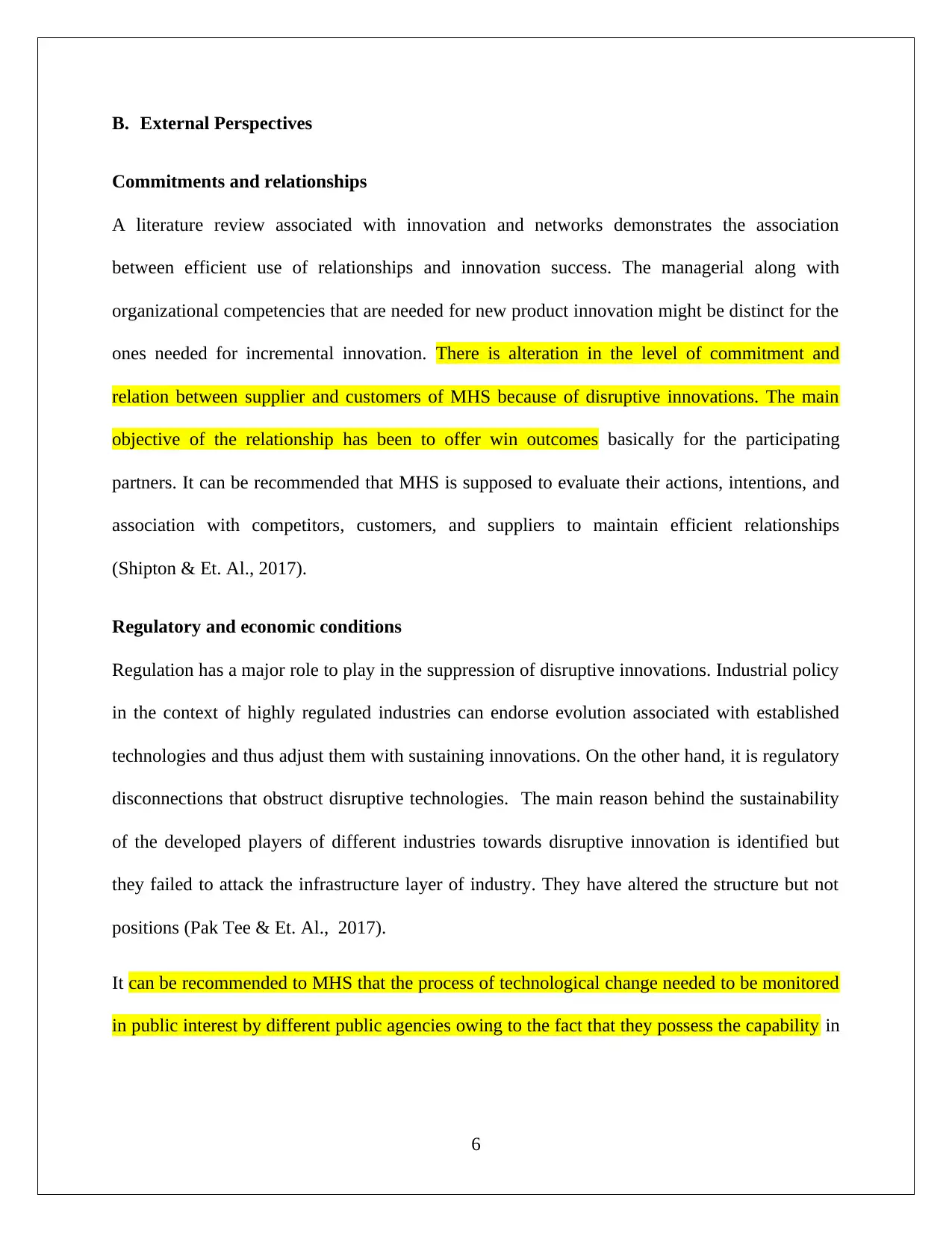
B. External Perspectives
Commitments and relationships
A literature review associated with innovation and networks demonstrates the association
between efficient use of relationships and innovation success. The managerial along with
organizational competencies that are needed for new product innovation might be distinct for the
ones needed for incremental innovation. There is alteration in the level of commitment and
relation between supplier and customers of MHS because of disruptive innovations. The main
objective of the relationship has been to offer win outcomes basically for the participating
partners. It can be recommended that MHS is supposed to evaluate their actions, intentions, and
association with competitors, customers, and suppliers to maintain efficient relationships
(Shipton & Et. Al., 2017).
Regulatory and economic conditions
Regulation has a major role to play in the suppression of disruptive innovations. Industrial policy
in the context of highly regulated industries can endorse evolution associated with established
technologies and thus adjust them with sustaining innovations. On the other hand, it is regulatory
disconnections that obstruct disruptive technologies. The main reason behind the sustainability
of the developed players of different industries towards disruptive innovation is identified but
they failed to attack the infrastructure layer of industry. They have altered the structure but not
positions (Pak Tee & Et. Al., 2017).
It can be recommended to MHS that the process of technological change needed to be monitored
in public interest by different public agencies owing to the fact that they possess the capability in
6
Commitments and relationships
A literature review associated with innovation and networks demonstrates the association
between efficient use of relationships and innovation success. The managerial along with
organizational competencies that are needed for new product innovation might be distinct for the
ones needed for incremental innovation. There is alteration in the level of commitment and
relation between supplier and customers of MHS because of disruptive innovations. The main
objective of the relationship has been to offer win outcomes basically for the participating
partners. It can be recommended that MHS is supposed to evaluate their actions, intentions, and
association with competitors, customers, and suppliers to maintain efficient relationships
(Shipton & Et. Al., 2017).
Regulatory and economic conditions
Regulation has a major role to play in the suppression of disruptive innovations. Industrial policy
in the context of highly regulated industries can endorse evolution associated with established
technologies and thus adjust them with sustaining innovations. On the other hand, it is regulatory
disconnections that obstruct disruptive technologies. The main reason behind the sustainability
of the developed players of different industries towards disruptive innovation is identified but
they failed to attack the infrastructure layer of industry. They have altered the structure but not
positions (Pak Tee & Et. Al., 2017).
It can be recommended to MHS that the process of technological change needed to be monitored
in public interest by different public agencies owing to the fact that they possess the capability in
6
⊘ This is a preview!⊘
Do you want full access?
Subscribe today to unlock all pages.

Trusted by 1+ million students worldwide
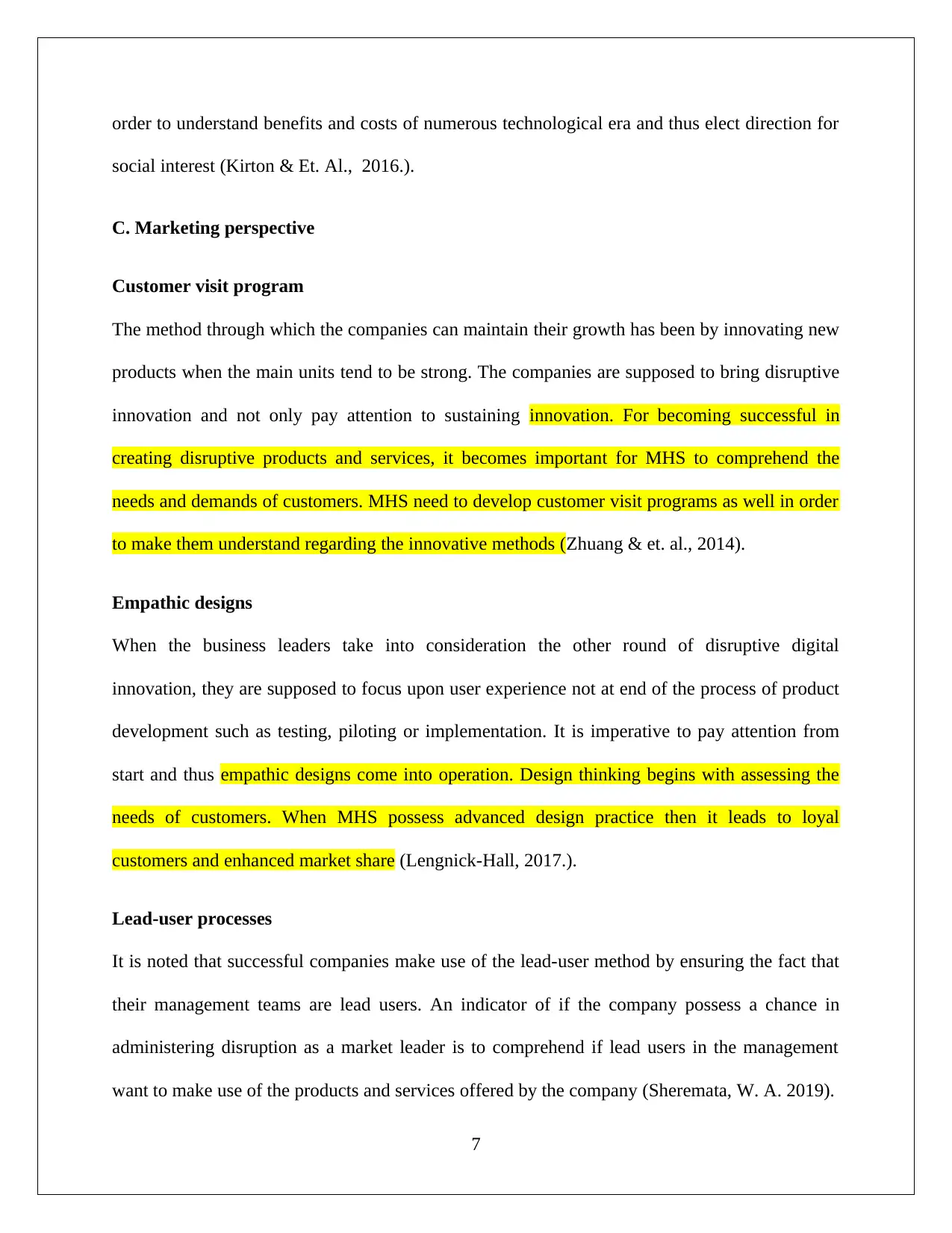
order to understand benefits and costs of numerous technological era and thus elect direction for
social interest (Kirton & Et. Al., 2016.).
C. Marketing perspective
Customer visit program
The method through which the companies can maintain their growth has been by innovating new
products when the main units tend to be strong. The companies are supposed to bring disruptive
innovation and not only pay attention to sustaining innovation. For becoming successful in
creating disruptive products and services, it becomes important for MHS to comprehend the
needs and demands of customers. MHS need to develop customer visit programs as well in order
to make them understand regarding the innovative methods (Zhuang & et. al., 2014).
Empathic designs
When the business leaders take into consideration the other round of disruptive digital
innovation, they are supposed to focus upon user experience not at end of the process of product
development such as testing, piloting or implementation. It is imperative to pay attention from
start and thus empathic designs come into operation. Design thinking begins with assessing the
needs of customers. When MHS possess advanced design practice then it leads to loyal
customers and enhanced market share (Lengnick-Hall, 2017.).
Lead-user processes
It is noted that successful companies make use of the lead-user method by ensuring the fact that
their management teams are lead users. An indicator of if the company possess a chance in
administering disruption as a market leader is to comprehend if lead users in the management
want to make use of the products and services offered by the company (Sheremata, W. A. 2019).
7
social interest (Kirton & Et. Al., 2016.).
C. Marketing perspective
Customer visit program
The method through which the companies can maintain their growth has been by innovating new
products when the main units tend to be strong. The companies are supposed to bring disruptive
innovation and not only pay attention to sustaining innovation. For becoming successful in
creating disruptive products and services, it becomes important for MHS to comprehend the
needs and demands of customers. MHS need to develop customer visit programs as well in order
to make them understand regarding the innovative methods (Zhuang & et. al., 2014).
Empathic designs
When the business leaders take into consideration the other round of disruptive digital
innovation, they are supposed to focus upon user experience not at end of the process of product
development such as testing, piloting or implementation. It is imperative to pay attention from
start and thus empathic designs come into operation. Design thinking begins with assessing the
needs of customers. When MHS possess advanced design practice then it leads to loyal
customers and enhanced market share (Lengnick-Hall, 2017.).
Lead-user processes
It is noted that successful companies make use of the lead-user method by ensuring the fact that
their management teams are lead users. An indicator of if the company possess a chance in
administering disruption as a market leader is to comprehend if lead users in the management
want to make use of the products and services offered by the company (Sheremata, W. A. 2019).
7
Paraphrase This Document
Need a fresh take? Get an instant paraphrase of this document with our AI Paraphraser
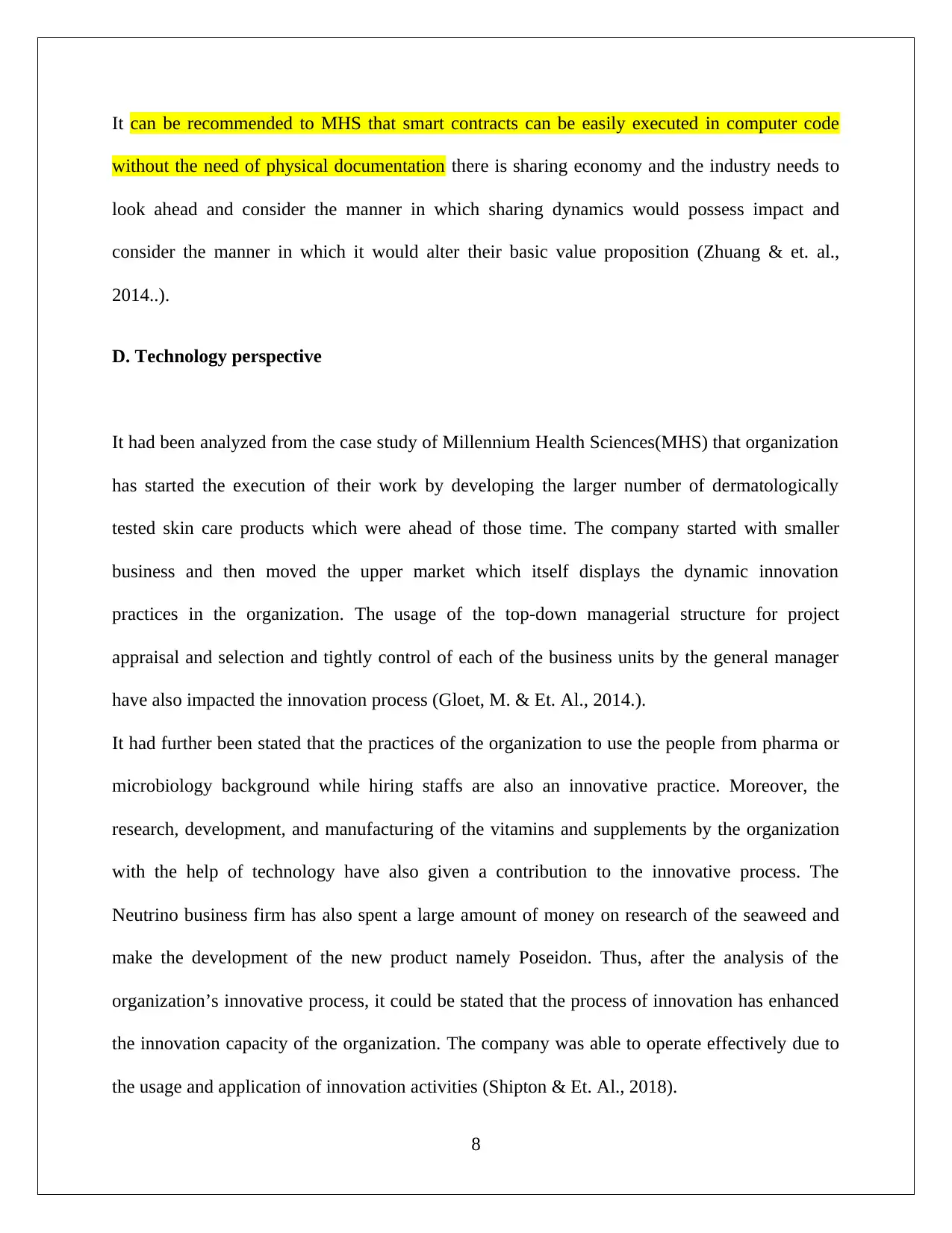
It can be recommended to MHS that smart contracts can be easily executed in computer code
without the need of physical documentation there is sharing economy and the industry needs to
look ahead and consider the manner in which sharing dynamics would possess impact and
consider the manner in which it would alter their basic value proposition (Zhuang & et. al.,
2014..).
D. Technology perspective
It had been analyzed from the case study of Millennium Health Sciences(MHS) that organization
has started the execution of their work by developing the larger number of dermatologically
tested skin care products which were ahead of those time. The company started with smaller
business and then moved the upper market which itself displays the dynamic innovation
practices in the organization. The usage of the top-down managerial structure for project
appraisal and selection and tightly control of each of the business units by the general manager
have also impacted the innovation process (Gloet, M. & Et. Al., 2014.).
It had further been stated that the practices of the organization to use the people from pharma or
microbiology background while hiring staffs are also an innovative practice. Moreover, the
research, development, and manufacturing of the vitamins and supplements by the organization
with the help of technology have also given a contribution to the innovative process. The
Neutrino business firm has also spent a large amount of money on research of the seaweed and
make the development of the new product namely Poseidon. Thus, after the analysis of the
organization’s innovative process, it could be stated that the process of innovation has enhanced
the innovation capacity of the organization. The company was able to operate effectively due to
the usage and application of innovation activities (Shipton & Et. Al., 2018).
8
without the need of physical documentation there is sharing economy and the industry needs to
look ahead and consider the manner in which sharing dynamics would possess impact and
consider the manner in which it would alter their basic value proposition (Zhuang & et. al.,
2014..).
D. Technology perspective
It had been analyzed from the case study of Millennium Health Sciences(MHS) that organization
has started the execution of their work by developing the larger number of dermatologically
tested skin care products which were ahead of those time. The company started with smaller
business and then moved the upper market which itself displays the dynamic innovation
practices in the organization. The usage of the top-down managerial structure for project
appraisal and selection and tightly control of each of the business units by the general manager
have also impacted the innovation process (Gloet, M. & Et. Al., 2014.).
It had further been stated that the practices of the organization to use the people from pharma or
microbiology background while hiring staffs are also an innovative practice. Moreover, the
research, development, and manufacturing of the vitamins and supplements by the organization
with the help of technology have also given a contribution to the innovative process. The
Neutrino business firm has also spent a large amount of money on research of the seaweed and
make the development of the new product namely Poseidon. Thus, after the analysis of the
organization’s innovative process, it could be stated that the process of innovation has enhanced
the innovation capacity of the organization. The company was able to operate effectively due to
the usage and application of innovation activities (Shipton & Et. Al., 2018).
8
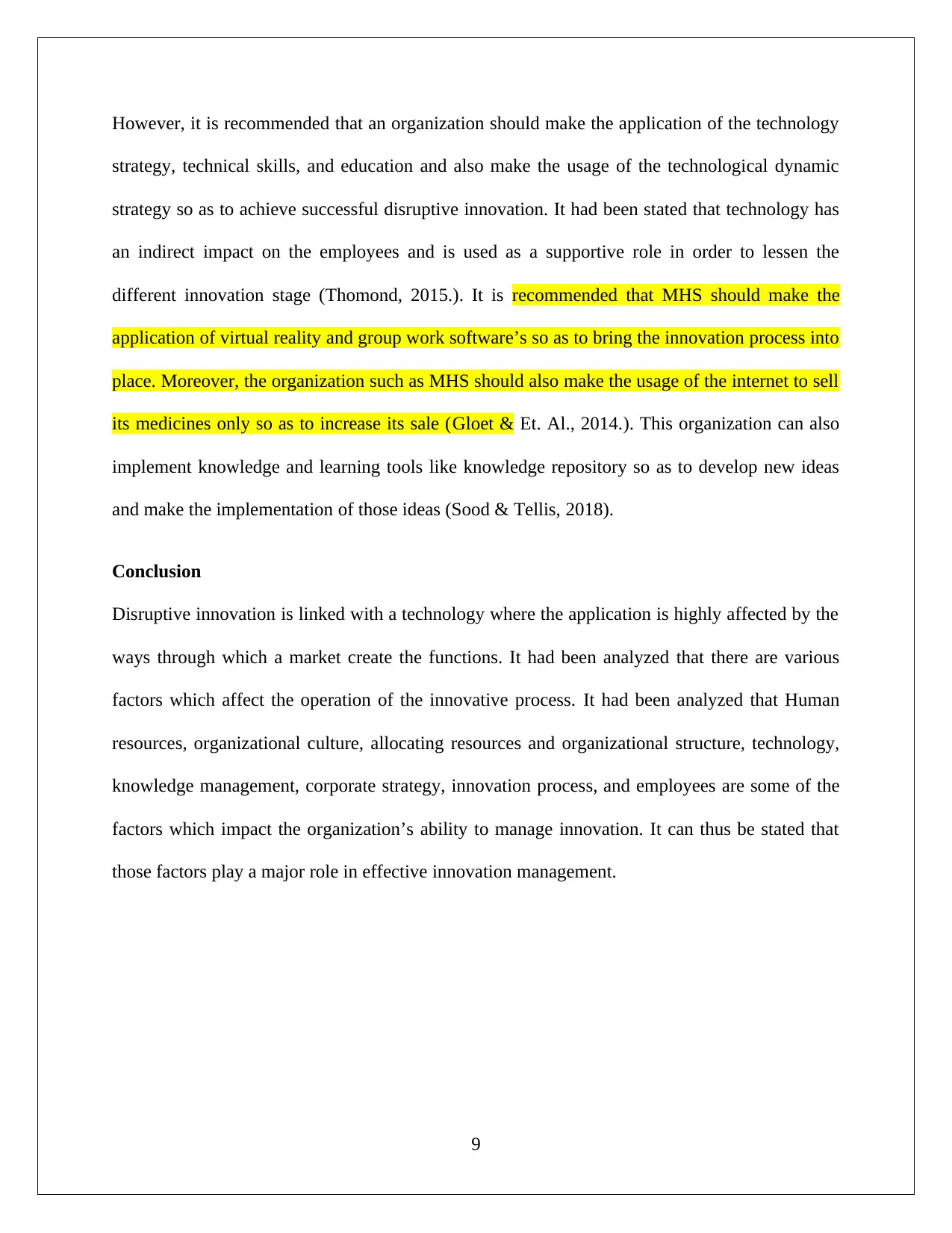
However, it is recommended that an organization should make the application of the technology
strategy, technical skills, and education and also make the usage of the technological dynamic
strategy so as to achieve successful disruptive innovation. It had been stated that technology has
an indirect impact on the employees and is used as a supportive role in order to lessen the
different innovation stage (Thomond, 2015.). It is recommended that MHS should make the
application of virtual reality and group work software’s so as to bring the innovation process into
place. Moreover, the organization such as MHS should also make the usage of the internet to sell
its medicines only so as to increase its sale (Gloet & Et. Al., 2014.). This organization can also
implement knowledge and learning tools like knowledge repository so as to develop new ideas
and make the implementation of those ideas (Sood & Tellis, 2018).
Conclusion
Disruptive innovation is linked with a technology where the application is highly affected by the
ways through which a market create the functions. It had been analyzed that there are various
factors which affect the operation of the innovative process. It had been analyzed that Human
resources, organizational culture, allocating resources and organizational structure, technology,
knowledge management, corporate strategy, innovation process, and employees are some of the
factors which impact the organization’s ability to manage innovation. It can thus be stated that
those factors play a major role in effective innovation management.
9
strategy, technical skills, and education and also make the usage of the technological dynamic
strategy so as to achieve successful disruptive innovation. It had been stated that technology has
an indirect impact on the employees and is used as a supportive role in order to lessen the
different innovation stage (Thomond, 2015.). It is recommended that MHS should make the
application of virtual reality and group work software’s so as to bring the innovation process into
place. Moreover, the organization such as MHS should also make the usage of the internet to sell
its medicines only so as to increase its sale (Gloet & Et. Al., 2014.). This organization can also
implement knowledge and learning tools like knowledge repository so as to develop new ideas
and make the implementation of those ideas (Sood & Tellis, 2018).
Conclusion
Disruptive innovation is linked with a technology where the application is highly affected by the
ways through which a market create the functions. It had been analyzed that there are various
factors which affect the operation of the innovative process. It had been analyzed that Human
resources, organizational culture, allocating resources and organizational structure, technology,
knowledge management, corporate strategy, innovation process, and employees are some of the
factors which impact the organization’s ability to manage innovation. It can thus be stated that
those factors play a major role in effective innovation management.
9
⊘ This is a preview!⊘
Do you want full access?
Subscribe today to unlock all pages.

Trusted by 1+ million students worldwide
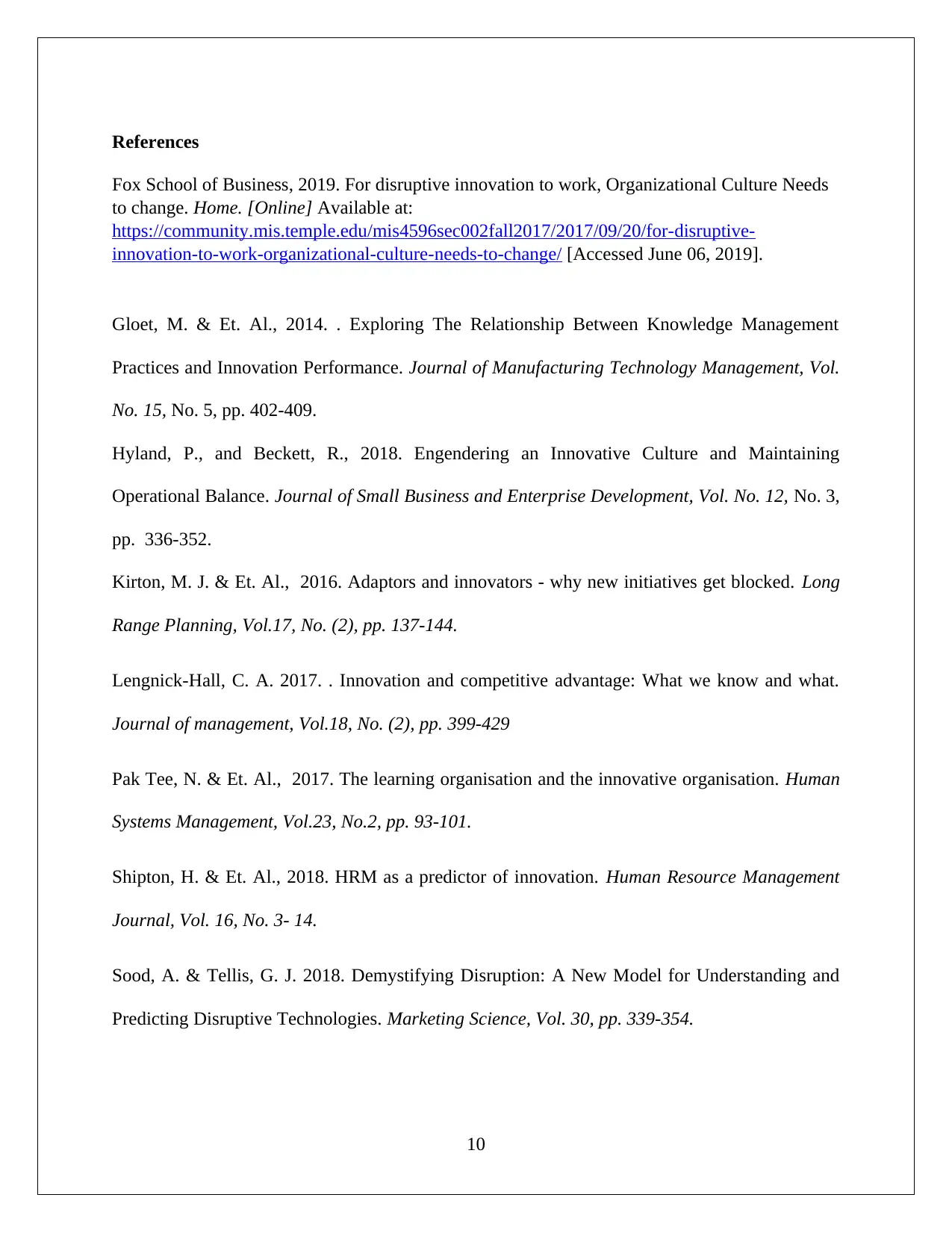
References
Fox School of Business, 2019. For disruptive innovation to work, Organizational Culture Needs
to change. Home. [Online] Available at:
https://community.mis.temple.edu/mis4596sec002fall2017/2017/09/20/for-disruptive-
innovation-to-work-organizational-culture-needs-to-change/ [Accessed June 06, 2019].
Gloet, M. & Et. Al., 2014. . Exploring The Relationship Between Knowledge Management
Practices and Innovation Performance. Journal of Manufacturing Technology Management, Vol.
No. 15, No. 5, pp. 402-409.
Hyland, P., and Beckett, R., 2018. Engendering an Innovative Culture and Maintaining
Operational Balance. Journal of Small Business and Enterprise Development, Vol. No. 12, No. 3,
pp. 336-352.
Kirton, M. J. & Et. Al., 2016. Adaptors and innovators - why new initiatives get blocked. Long
Range Planning, Vol.17, No. (2), pp. 137-144.
Lengnick-Hall, C. A. 2017. . Innovation and competitive advantage: What we know and what.
Journal of management, Vol.18, No. (2), pp. 399-429
Pak Tee, N. & Et. Al., 2017. The learning organisation and the innovative organisation. Human
Systems Management, Vol.23, No.2, pp. 93-101.
Shipton, H. & Et. Al., 2018. HRM as a predictor of innovation. Human Resource Management
Journal, Vol. 16, No. 3- 14.
Sood, A. & Tellis, G. J. 2018. Demystifying Disruption: A New Model for Understanding and
Predicting Disruptive Technologies. Marketing Science, Vol. 30, pp. 339-354.
10
Fox School of Business, 2019. For disruptive innovation to work, Organizational Culture Needs
to change. Home. [Online] Available at:
https://community.mis.temple.edu/mis4596sec002fall2017/2017/09/20/for-disruptive-
innovation-to-work-organizational-culture-needs-to-change/ [Accessed June 06, 2019].
Gloet, M. & Et. Al., 2014. . Exploring The Relationship Between Knowledge Management
Practices and Innovation Performance. Journal of Manufacturing Technology Management, Vol.
No. 15, No. 5, pp. 402-409.
Hyland, P., and Beckett, R., 2018. Engendering an Innovative Culture and Maintaining
Operational Balance. Journal of Small Business and Enterprise Development, Vol. No. 12, No. 3,
pp. 336-352.
Kirton, M. J. & Et. Al., 2016. Adaptors and innovators - why new initiatives get blocked. Long
Range Planning, Vol.17, No. (2), pp. 137-144.
Lengnick-Hall, C. A. 2017. . Innovation and competitive advantage: What we know and what.
Journal of management, Vol.18, No. (2), pp. 399-429
Pak Tee, N. & Et. Al., 2017. The learning organisation and the innovative organisation. Human
Systems Management, Vol.23, No.2, pp. 93-101.
Shipton, H. & Et. Al., 2018. HRM as a predictor of innovation. Human Resource Management
Journal, Vol. 16, No. 3- 14.
Sood, A. & Tellis, G. J. 2018. Demystifying Disruption: A New Model for Understanding and
Predicting Disruptive Technologies. Marketing Science, Vol. 30, pp. 339-354.
10
Paraphrase This Document
Need a fresh take? Get an instant paraphrase of this document with our AI Paraphraser
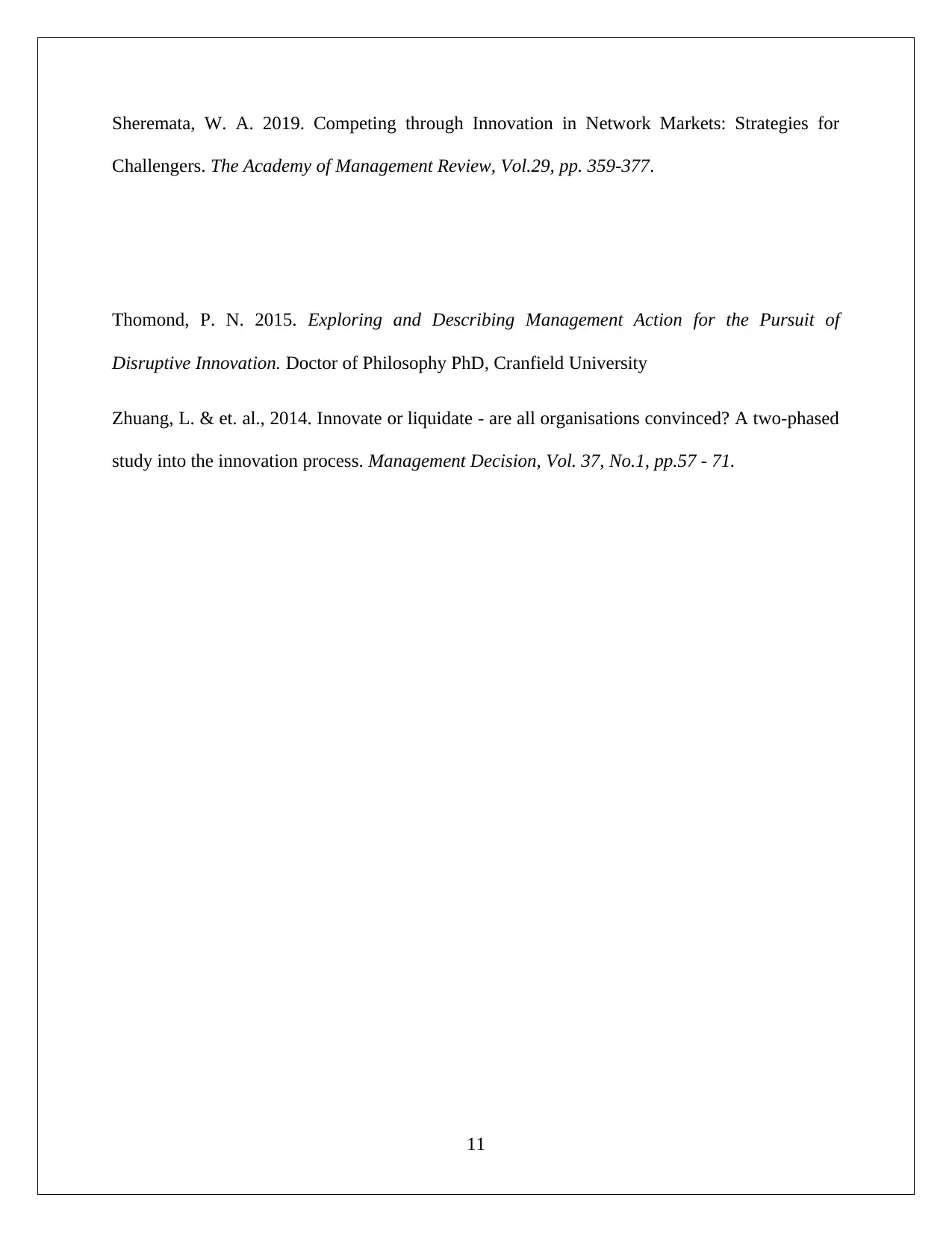
Sheremata, W. A. 2019. Competing through Innovation in Network Markets: Strategies for
Challengers. The Academy of Management Review, Vol.29, pp. 359-377.
Thomond, P. N. 2015. Exploring and Describing Management Action for the Pursuit of
Disruptive Innovation. Doctor of Philosophy PhD, Cranfield University
Zhuang, L. & et. al., 2014. Innovate or liquidate - are all organisations convinced? A two-phased
study into the innovation process. Management Decision, Vol. 37, No.1, pp.57 - 71.
11
Challengers. The Academy of Management Review, Vol.29, pp. 359-377.
Thomond, P. N. 2015. Exploring and Describing Management Action for the Pursuit of
Disruptive Innovation. Doctor of Philosophy PhD, Cranfield University
Zhuang, L. & et. al., 2014. Innovate or liquidate - are all organisations convinced? A two-phased
study into the innovation process. Management Decision, Vol. 37, No.1, pp.57 - 71.
11
1 out of 11
Related Documents
Your All-in-One AI-Powered Toolkit for Academic Success.
+13062052269
info@desklib.com
Available 24*7 on WhatsApp / Email
![[object Object]](/_next/static/media/star-bottom.7253800d.svg)
Unlock your academic potential
Copyright © 2020–2025 A2Z Services. All Rights Reserved. Developed and managed by ZUCOL.





